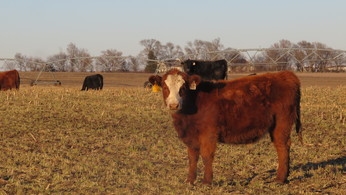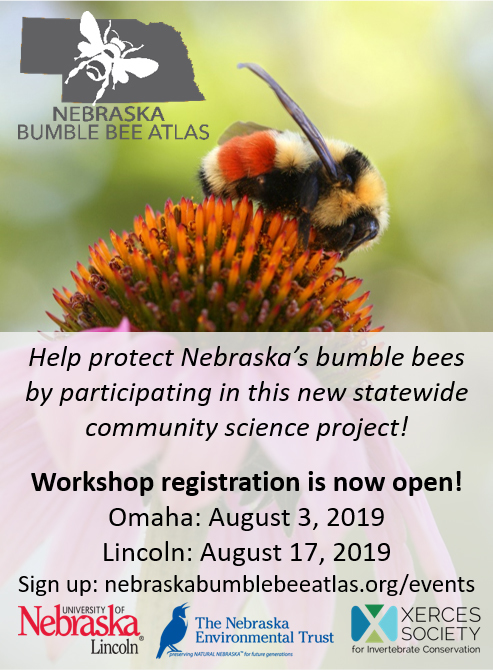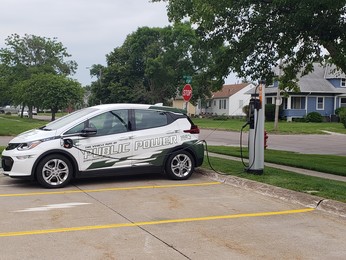|
Executive Director Corner
Is it me or is the summer passing by at warp speed? After flooding this late winter/early spring, we had severe flooding again in Central Nebraska a few weeks ago. I traveled through the Kearney area a few days after they received over 9 inches of rain and there were still parking lots by the Interstate that looked like ponds. Then the current heat wave hit. My car read 108 degrees when I got in it the other day and it dropped to 106 degrees by the time I got home. That evening it was still at 91 degrees after 11pm.
Last month I had the good fortune of attending the Nebraska Grazing Lands Coalition and Nebraska Extension 2019 Summer Grazing Tour. The three site visits were to the Shamrock Ranch, Deatrich Cattle Company and Mortensen Farm and Ranch all in Southwest Nebraska. We were able to see first-hand mob grazing, water systems and pipelines, prescribed fire and various mechanical tree removal, deferred grazing and other land management practices.
The Nebraska Youth Ranch Camp was taking place in Curtis and the participants were able to join us for the afternoon tours and a meal that evening. On the same trip I was able to participate in a field day at the 2019 Leopold Conservation Award winner’s Broken Box Ranch south of Brady. The Sundstrom family were gracious hosts.
I thought I put in some long hours, but I learned that Russ Sundstrom has a full-time railroad job in nearby North Platte, runs a tree cutting business and operates the ranch. Russ was quick to point out he couldn’t do it without his wife Angela and daughter Cheyenne. Seeing the recently cleared pastures compared to the surrounding cedar covered lands really showed the loss of grazing potential and wildlife habitat. Russ is working with a lot of partners and neighbors to address the cedar problem. Russ and the other three operators are doing great things and made me proud to be a Nebraskan.
A trip to Sioux County to visit a conservation easement the Trust participated in and another that might come up, was very special. On one I met a lady that was an absolute joy. She runs her ranch and a bed and breakfast. The ranch abutted Toadstool Park and was like a postcard. The other property was south of Fort Robinson along the Snake River and the granddaughter and three young kids are running the ranch that has been in the family for generations. I have to admit, it has been a long time since I met two more passionate and impressive ranch operators. These two ladies really impressed me. Being a ranch kid, I understand the challenges they face and the flooding issues they had to deal with this spring were even more daunting then those we faced on our family ranch in Custer County.
The Husker men’s basketball team seems to be gaining a lot of momentum with the recent hire of Coach Fred Hoiberg. The football team is getting a lot of press with the Big 10 media days going on this week in Chicago. It seems everyone wants to talk to Coach Frost and quarterback Adrian Martinez. Martinez is getting some Heisman hype and Coach Frost has said there is not another college quarterback he would rather have on his team. The Huskers are now picked to win the Big 10 West. The 4-8 team will be led by the sophomore Martinez who said he put on a little weight in the off-season. He was quick to point out it was muscle and not fat. All I gotta say, buckle up Husker fans it might be a wild ride.
Travel safe.
Mark A. Brohman
Executive Director
Exploring Ties Between Cover Crops, Grazing, Soil Health and Economics
Cover crops have the potential to improve soil health and sustainability of cropping operations. However, incorporating cover crops into cropping systems incur economic costs that may discourage some producers from adopting this practice. Using cover crops as a forage source can be a way to offset the economic costs and generate additional revenue. The limited data available suggests that grazing of cover crops may not negate the soil health benefits. Therefore, both economic and soil health incentives may be present for crop producers to incorporate grazing of cover crops into their system.
The goal of the project is to learn more about the impacts of grazing cover crops on the sustainability of the system and to inform Nebraska crop and cattle producers of the potential for incorporating cover crops and grazing into their system.
One, of several, systems being evaluated is the incorporation of an oats cover crop after corn silage production. Corn silage is produced on about 220,000 acres in Nebraska and is a great feed resource for cattle producers. However, the harvest of corn silage results in removal of almost all of the soil cover in the field resulting in an increased risk of erosion, if a cover crop is not planted. Planting oats after early harvested corn silage can significantly improve ground cover and reduce erosion potential. Our research shows that grazing these oats can provide cost effective gains on calves with only minor reductions in ground cover. Soil samples have been taken and extensive analysis of the effects of the cover crop with and without grazing is underway. We should know more about soil health impacts soon but the current data looks promising that cattle producers can “have their cake and eat it too” when grazing oats cover crops in corn silage systems.
 Calf Grazing on oats in corn silage field

Nebraska Bumble Bee Atlas Project Aims to Engage Community Scientists in Tracking Bumble Bees
A new project provides an opportunity for community scientists to work alongside researchers to better understand the status of Nebraska’s bumble bees. The state is home to nearly 20 different species of these charismatic and easily recognizable bees, many of which have been affected by the dramatic land use change seen in the Midwest over the last 150 years. The Nebraska Bumble Bee Atlas is spearheaded by the University of Nebraska-Lincoln and the Xerces Society for Invertebrate Conservation.
Pollinators play an essential role in sustaining the health of our environment by pollinating flowers in natural areas and contributing to successful harvests on farms. In recent years however, much of the recognition pollinators have received largely stems from the widespread decline of bees.
Declines of pollinator populations are alarming. Much attention has been given to the plight of the introduced European honey bee. Less well publicized, but no less important, is the parallel decline of native, wild bee populations, particularly bumble bees.
While this project will target all bumble bees, there are four species of particular concern that Nebraska Game and Parks has identified as Species of Greatest Conservation Need, which include the western bumble bee (Bombus occidentalis), southern plains bumble bee (Bombus fraternus), Suckley’s cuckoo bumble bee (Bombus suckleyi) and variable cuckoo bumble bee (Bombus variabilis).
The Nebraska Bumble Bee Atlas will make use of the North American community-science platform Bumble Bee Watch to collect data.
“Whether you’re a career scientist or even just slightly interested in nature, community science provides an opportunity for the public and researchers to work together,” said Louise Lynch-O’Brien, Assistant Professor of Insect Biology at the University of Nebraska–Lincoln. “Right now, our pollinators in Nebraska and beyond are facing all sorts of problems. Research is how we get a handle on these problems. It is always exciting to see community science efforts, like the Nebraska Bumble Bee Atlas, in action. This is a chance for anyone to get off the sidelines and do something about pollinator declines and conservation efforts.”
Nebraska has a rich history of publishing bumble bee distribution information going back to the early 1960s. The Bumble Bee Atlas project will build upon this to better understand how bumble bee distributions have changed through time, including in rural areas of the state. Recent information on bumble bee distribution has been focused on places where people live and gathering information outside of these areas will be key to the success of the project. Doing so will take the cooperation of stakeholders throughout the state, and a team of trained volunteers eager to collect the data.
"With much of state in private ownership, many areas have never been visited to document what bumble bee species exist there,” said Doug Golick, Associate Professor of Entomology at the University of Nebraska-Lincoln. “Who knows? Maybe a community scientist will find a species currently undocumented in Nebraska.”
To help launch the project there will be several community science volunteer training events throughout July and August 2019. The events will help community scientists connect with other volunteers while learning about bumble bees and how to contribute to the atlas.
“Because Nebraska is home to so many unique habitats, we also have unique bumble bee communities, with a mix of species found in both the eastern and western United States,” said Jennifer Hopwood, Senior Pollinator Conservation Specialist, Midwest Region, for the Xerces Society. “Getting a clear understanding of where bumble bees are thriving, as well as documenting the plant species and habitats that are supporting them, will help us be able to better develop evidence-based pollinator conservation plans throughout the state.”
Conservation partners throughout Nebraska and beyond look forward to the lasting effects of this project.
“Bees and other pollinators serve a very important role in our environment, and monitoring efforts are necessary to better identify the current distribution and population status of Nebraska’s at-risk bumble bees,” said Melissa Panella, Wildlife Diversity Program Manager for Nebraska Game and Parks Commission. “The Nebraska Bumble Bee Atlas is a fantastic opportunity for cooperation with community scientists to help Nebraska Game and Parks Commission managers make more-informed decisions that will have the greatest positive impact on our bumble bees.”
The Nebraska Bumble Bee Atlas is funded through a grant from the Nebraska Environmental Trust. The Trust is funded by proceeds from the Nebraska Lottery and has awarded more than $305 million to more than 2,200 conservation projects across the state of Nebraska since 1994.
Training Workshops
The Xerces Society will be organizing two training workshops that will orient & familiarize participants with the Atlas project as well as bumble bee ecology, identification and conservation. Registration links for both are here: https://www.nebraskabumblebeeatlas.org/events.html
-
Nebraska Bumble Bee Atlas training: Omaha
-
Nebraska Bumble Bee Atlas training: Lincoln
 Electric Vehicle at the NPPD Office's New Charging Station
Incentives for electric vehicles, charging stations now available
Interest continues to grow among consumers when it comes to purchasing a new vehicle - specifically an electric vehicle (EV).
One of the obstacles facing consumers about EVs is the upfront cost for the vehicle and installing charging stations. As part of an incentive program, Nebraska Public Power District, in partnership with its wholesale utility customers and the Nebraska Environmental Trust (NET) and the Nebraska Community Energy Alliance (NCEA), has introduced three programs which help to reduce the purchase price of an EV.
“We have been fortunate to receiving grant money from NET through a partnership with the NCEA which is very much appreciated,” said NPPD President and CEO Pat Pope. “The grant money will be an incentive to those wanting an electric vehicle and are faced with upfront costs and installing charging stations at their residence. NPPD will also be working with auto dealers and home builders to promote these incentives.”
"The Nebraska Environmental Trust is excited to increase the number of electric vehicles in use across Nebraska," said Executive Director of the Nebraska Environmental Trust Mark Brohman. "Nebraska Public Power District can use the charging information shared from these smart home charging stations to find ways the utility can benefit from electrified transportation."
The largest available incentive is for EV and a ChargePoint home charging station in the amount of $4,500, with $4,000 going towards the purchase of a vehicle. Another $500 would be available for the charging station installation at a single or multi-family residential location with internet wireless connectivity.
Two other incentives are also available: One is for a ChargePoint home charging station installation of $500 and a $100 incentive is available for the pre-wiring for the installation of a residential EV charging station in the future.
“The Nebraska Community Energy Alliance (NCEA) must prove for the Nebraska Environmental Trust, which grants public funds, the economic and environmental benefits of electrified transportation," said NCEA Director Anne McCollister. "As Nebraska Public Power District offers Trust-funded rebates this year for electric vehicles and home charging stations to help populate its utility study, we expect to see the same cost savings and emissions reductions in the second year we found in the first year of studying residential home charging.”
Details of all three incentive programs can be found at https://www.nppd.com/save-money/incentives-programs#electric-vehicle. The incentives are available to NPPD retail customers and customers of its wholesale utilities.
The mission of the Nebraska Community Energy Alliance is to build and promote advanced technologies for housing and transportation that save energy, reduce CO2 pollution and to cut costs.
Upcoming Events
- August 5 - 6, 2019 - 3rd Quarter Board Meeting, Beatrice, NE.
- August 12-14, 2019 - Nebraska Grazing Conference, Kearney NE.
- August 23 - Sep. 2, 2019 - Nebraska State Fair, Grand Island, NE.
- September 3, 2019 - Grants Deadline
- September 7, 2019 - World O Water Fest, Omaha, NE.
- September 7, 2019 - Wetland Festival, Heron Haven, Omaha NE.
- September 21-22, 2019 - Missouri River Outdoor Expo, Ponca State Park, Ponca NE.
- October 3, 2019 - Golden Rod Festival Lauritzen Gardens
- November 7, 2019 - 4th Quarter Board Meeting, 1:30 pm, Ferguson House.
|